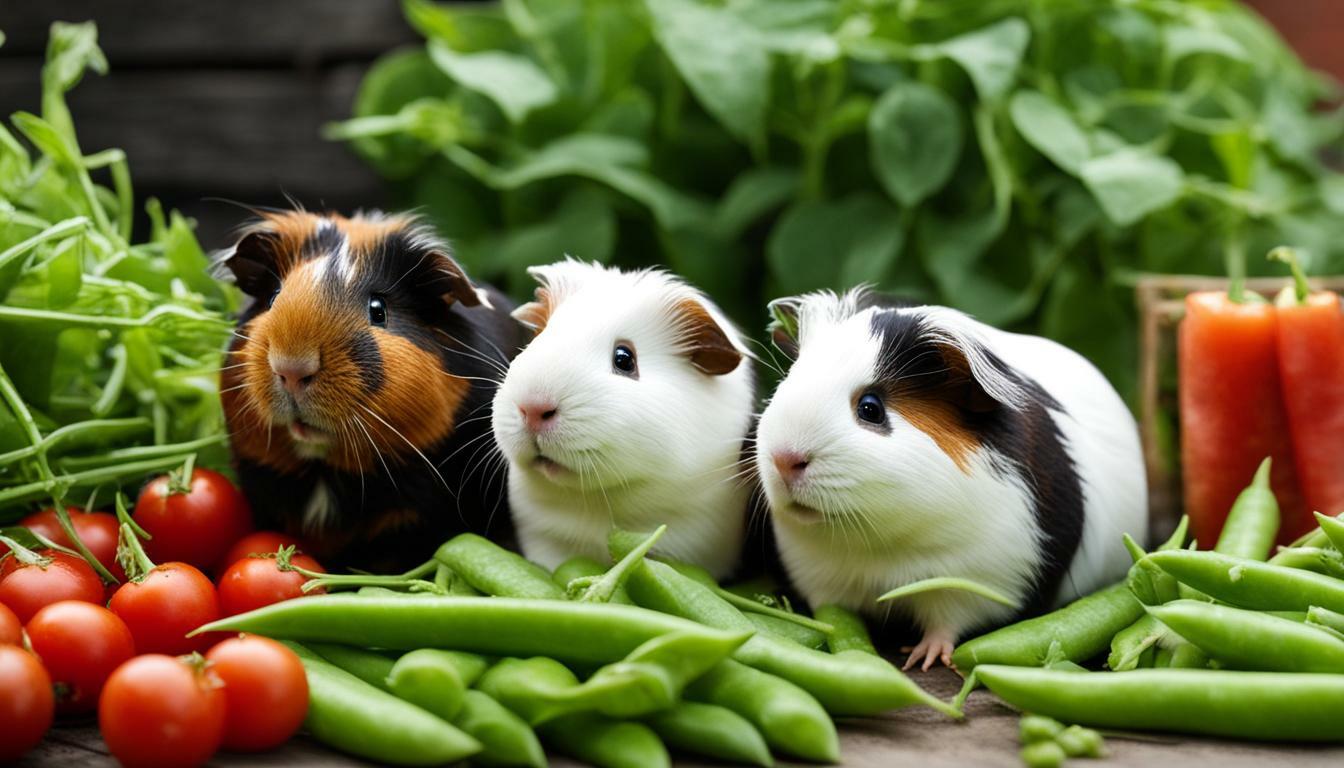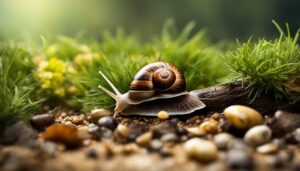Guinea pigs can enjoy the occasional treat of snap peas, but there are a few things to keep in mind. Snap peas, also known as sugar snap peas, are safe for guinea pigs to eat in moderation.
They can provide a refreshing and nutritious addition to their diet. However, it is important to understand the nutritional value of snap peas for guinea pigs and how to properly incorporate them into their meals.
Key Takeaways:
- Snap peas are safe for guinea pigs to eat in moderation.
- They are a great source of water, vitamin C, and fiber.
- Remove the string before feeding snap peas to guinea pigs.
- Serve snap peas raw and fresh, discarding the pods.
- Avoid canned snap peas due to preservatives.
Incorporating Snap Peas into a Guinea Pig Diet
When introducing snap peas to a guinea pig’s diet, it is important to do so gradually to avoid any digestive issues.
Guinea pigs have sensitive digestive systems, and sudden dietary changes can lead to problems like diarrhea or upset stomach.
Start by offering a small portion of snap peas and observe how your guinea pig reacts. If there are no adverse reactions, you can gradually increase the amount over time.
It’s essential to include a variety of safe vegetables in a guinea pig’s diet to ensure they receive a balanced nutritional intake.
Snap peas can be a great addition due to their high water content, which helps keep guinea pigs hydrated.
They are also rich in vitamin C, an essential nutrient that guinea pigs cannot produce on their own.
Additionally, snap peas provide dietary fiber, which aids in digestion and keeps the digestive system healthy.
When serving snap peas to your guinea pig, it is crucial to remove the string, as it can be challenging for them to chew and digest.
The string can cause discomfort or even intestinal blockages. It’s also important to serve snap peas raw and fresh.
The pods should be discarded, as they might contain contaminants that can be harmful to guinea pigs.
Remember, frozen snap peas should be thawed before serving, but canned peas should be avoided due to the preservatives they contain.
Cooked snap peas are not recommended for guinea pigs as they may lose some of their nutritional value.
Serving Snap Peas to Guinea Pigs – Dos and Don’ts
| Do | Don’t |
|---|---|
| Gradually introduce snap peas to your guinea pig’s diet | Serve canned snap peas |
| Remove the string before serving | Feed cooked snap peas |
| Serve snap peas raw and fresh | Include only snap peas in your guinea pig’s diet |
| Thaw frozen snap peas before serving | Overfeed snap peas to your guinea pig |
Introducing snap peas to your guinea pig’s diet can be a healthy and enjoyable addition. Remember to serve them in moderation and alongside other low calcium vegetables to ensure a balanced diet.
Keep a close eye on your guinea pig’s health and consult a veterinarian if you have any concerns or questions about their diet.
By incorporating snap peas responsibly, you can provide your guinea pig with a varied and nutritious diet to support their overall well-being.
Nutritional Benefits of Snap Peas for Guinea Pigs
Snap peas are a nutritious addition to a guinea pig’s diet, providing essential vitamins and minerals.
These crunchy vegetables offer a range of health benefits that contribute to the overall well-being of your furry friend.
One of the key nutritional advantages of snap peas is their high water content, which helps keep guinea pigs hydrated.
Additionally, snap peas are rich in vitamin C, a crucial nutrient that guinea pigs cannot produce on their own.
Vitamin C is essential for their overall health, supporting their immune system and promoting healthy growth.
Furthermore, snap peas are a great source of fiber, promoting a healthy digestive system for guinea pigs.
Fiber aids in proper digestion, prevents constipation, and supports optimal gut health. Including snap peas in your guinea pig’s diet can help prevent digestive problems and keep their digestive tract functioning properly.
| Nutrient | Amount per 100g of Snap Peas |
|---|---|
| Vitamin C | 60mg |
| Fiber | 3g |
| Water | 89g |
While snap peas offer numerous nutritional benefits, it’s essential to remember that they should not be the sole vegetable in a guinea pig’s diet.
Variety is key to providing a well-balanced diet for your pet. It’s recommended to mix snap peas with other low calcium vegetables to ensure a diverse range of nutrients.
Remember to serve snap peas raw and fresh. Remove the string before feeding them to your guinea pig to prevent any potential choking hazards.
Also, be sure to discard the pods as they may contain contaminants. Frozen snap peas should be thawed before serving, while canned peas should be avoided due to preservatives.
Cooked snap peas are not recommended for guinea pigs, as they may lose some of their nutritional value during the cooking process.
Keep in mind that moderation is key when feeding snap peas to your guinea pig. Overfeeding can lead to health issues such as obesity, diarrhea, and urinary problems.
If you have any concerns or questions about your guinea pig’s diet, it’s always best to consult with a veterinarian who can provide personalized advice based on your pet’s specific needs.
Preparing Snap Peas for Guinea Pigs
Before serving snap peas to guinea pigs, it is important to properly prepare them to ensure their safety.
Snap peas are a nutritious addition to a guinea pig’s diet, but certain steps must be taken to remove any potential risks. Here are some guidelines for preparing snap peas for your furry friends:
- Start by washing the snap peas thoroughly under cold water. This will help remove any dirt or pesticides that may be present on the surface.
. - Next, remove the string found along the side of the snap peas. The string can be tough and difficult for guinea pigs to chew and digest, so it is essential to take it off before serving.
. - After removing the string, you can cut the snap peas into smaller, bite-sized pieces. This will make it easier for guinea pigs to eat and reduce the risk of choking hazards.
.. - Discard the pods of the snap peas as they are not suitable for guinea pig consumption. The pods may contain contaminants or be harder to digest for these small animals.
By following these preparation steps, you can ensure that the snap peas are safe for your guinea pigs to enjoy.
Remember, moderation is key when introducing any new food to your pet’s diet. Serve snap peas in small quantities and mix them with other low calcium vegetables to provide a balanced and varied meal.
| Preparation Steps for Snap Peas |
|---|
| Wash snap peas under cold water to remove dirt and pesticides. |
| Remove the string found along the side of the snap peas. |
| Cut snap peas into smaller, bite-sized pieces. |
| Discard the pods of the snap peas. |
Raw Snap Peas vs. Frozen and Canned Peas
When it comes to serving snap peas to guinea pigs, it is best to opt for raw snap peas. Guinea pigs enjoy the crunchy texture and high water content of raw snap peas, making them a healthy and refreshing addition to their diet.
However, frozen snap peas can also be given to guinea pigs after thawing them properly. Thawing frozen peas ensures that they are easier for guinea pigs to eat and digest.
On the other hand, canned snap peas should be avoided when feeding guinea pigs. Canned peas usually contain additives and preservatives that are not suitable for their delicate digestive systems.
It is important to prioritize the freshness and natural state of the food for the overall well-being of guinea pigs.
To ensure the safety of guinea pigs, it is crucial to remove the string from snap peas before serving them.
The string can be difficult for guinea pigs to chew and may cause digestive issues if ingested.
Additionally, guinea pigs should only consume the snap pea pods in small quantities, as they may contain contaminants that could be harmful to their health.
| Type of Snap Peas | Serving Recommendation |
|---|---|
| Raw Snap Peas | Remove string, serve fresh, discard pods |
| Frozen Snap Peas | Thaw before serving, remove string, discard pods |
| Canned Snap Peas | Avoid due to preservatives |
It’s important to remember that while snap peas can be a healthy addition to a guinea pig’s diet, they should not be the sole focus.
Guinea pigs require a variety of vegetables to meet their nutritional needs. To provide a balanced diet, mix snap peas with other low calcium vegetables to ensure a robust intake of essential vitamins and minerals.
However, it is crucial to avoid overfeeding snap peas to guinea pigs. Consuming excessive amounts of snap peas can lead to health issues such as obesity, diarrhea, and urinary problems.
As always, it is advisable to consult with a veterinarian who specializes in guinea pig care to ensure that you are feeding your furry friend a suitable diet.
Avoiding Overfeeding Snap Peas to Guinea Pigs
While snap peas can be a healthy addition to a guinea pig’s diet, it is essential to feed them in moderation.
These crunchy vegetables are packed with water, vitamin C, and fiber, which can benefit your furry friend’s overall health.
However, overfeeding snap peas to guinea pigs can lead to various health issues, including obesity, diarrhea, and urinary problems.
When including snap peas in your guinea pig’s diet, it is important to remember that they should not be the sole vegetable source.
A well-rounded guinea pig diet consists of hay, pellets, fresh water, and a variety of other safe vegetables.
Snap peas should only make up a small portion of their overall vegetable intake. Mixing snap peas with other low calcium vegetables, such as bell peppers and cucumbers, can provide a balanced and varied diet for your guinea pig.
It is crucial to monitor the quantity of snap peas you feed your guinea pig. A general guideline is to offer a small handful of snap peas per serving, a couple of times per week.
This ensures they receive the nutritional benefits without overindulging. It is always better to underfeed snap peas than to overfeed them, as excessive intake can disrupt their digestive system and lead to discomfort.
If you are unsure about how much snap peas to feed your guinea pig, it is always recommended to consult with a veterinarian.
They can provide personalized advice based on your guinea pig’s individual needs and help you create a well-balanced diet plan.
By following these guidelines and practicing moderation, you can safely incorporate snap peas into your guinea pig’s diet, contributing to their overall health and well-being.
Mixing Snap Peas with Other Vegetables
To ensure a well-rounded diet, snap peas can be mixed with other vegetables to offer guinea pigs a variety of nutrients.
These small, crisp peas are not only a tasty treat for your furry friend but also provide essential vitamins and minerals to support their overall health.
When selecting vegetables to mix with snap peas, it is important to consider their nutritional content and the specific needs of guinea pigs.
One great way to serve snap peas is by including them in a salad mix. By combining a variety of safe vegetables, you can create a colorful and nutritious meal for your guinea pig.
Some safe vegetables that can be mixed with snap peas include bell peppers, cucumbers, spinach, and carrots.
These vegetables are low in calcium and high in vitamin C, which is vital for guinea pigs since they cannot produce this vitamin on their own.
When mixing vegetables, it is important to introduce new items gradually to avoid any digestive upset.
Start by offering small portions of snap peas mixed with other vegetables, and observe your guinea pig’s response.
If they enjoy the mix and show no signs of discomfort, you can slowly increase the amount over time.
Always ensure that the vegetables are thoroughly washed and cut into appropriate sizes for your guinea pig to prevent choking hazards.
| Safe Vegetables for Guinea Pigs: | Unsafe Vegetables for Guinea Pigs: |
|---|---|
|
Remember that while snap peas offer numerous health benefits, they should still be given in moderation. Aim to provide a balanced mix of vegetables, fresh hay, and guinea pig pellets as the main components of a guinea pig’s diet. It is important to consult with a veterinarian to ensure you are meeting your guinea pig’s specific dietary needs and maintaining their overall wellbeing.
Potential Risks of Feeding Snap Peas to Guinea Pigs
While snap peas are generally safe for guinea pigs, there are some risks to be aware of, especially when it comes to serving size and frequency. It is important to remember that snap peas should not be the only vegetable in a guinea pig’s diet, as they need a variety of nutrients to maintain their health. Here are some potential risks to consider:
- Overfeeding: Although snap peas are packed with vitamins and fiber, feeding them in excessive amounts can lead to health issues. Overeating snap peas can cause obesity, diarrhea, and urinary problems in guinea pigs. It is crucial to serve snap peas in moderation and ensure they are balanced with other vegetables in the guinea pig’s diet.
- Contaminants: When feeding snap peas to guinea pigs, it is important to remove the string and discard the pods. The string can be difficult for guinea pigs to digest, and the pods may contain contaminants. Serving only the edible parts of the snap peas ensures the safety of your pet.
Table: Safe Serving Size of Snap Peas for Guinea Pigs
| Guinea Pig Size | Serving Size of Snap Peas |
|---|---|
| Small (up to 1 lb) | 1-2 snap peas per day |
| Medium (1-2 lbs) | 2-3 snap peas per day |
| Large (2 lbs or more) | 3-4 snap peas per day |
By following these serving size recommendations, you can prevent overfeeding and ensure your guinea pig receives the right amount of nutrition. If you have any concerns about your guinea pig’s diet or health, it is always best to consult with a veterinarian for professional advice.
Other Considerations for Guinea Pig Diet
While snap peas can be enjoyed by guinea pigs, they should be part of a well-balanced diet that includes hay, pellets, and fresh water. These small, furry creatures have specific dietary needs that must be met to ensure their health and well-being. Here are some important considerations when it comes to guinea pig diet:
- Hay: Guinea pigs require a constant supply of fresh hay, such as timothy hay, which is essential for proper digestion and dental health. Hay provides the necessary fiber for their diet and helps wear down their continuously growing teeth.
. - Pellets: High-quality guinea pig pellets should make up a significant portion of their diet. Look for pellets that are specifically formulated for guinea pigs and contain essential nutrients such as vitamin C, which is crucial for their overall health. Avoid pellets that include nuts, seeds, or dried fruit, as these can be high in fat and sugar.
. - Fresh Water: Guinea pigs need access to clean, fresh water at all times. Ensure that their water bottle or bowl is refilled daily, and the container is kept clean to prevent bacterial growth.
In addition to these staples, it is important to introduce a variety of safe vegetables into their diet to provide additional nutrients.
Snap peas can be a great addition, but they should not be the sole vegetable consumed by guinea pigs.
When feeding snap peas to guinea pigs, it is essential to remove the string and discard the pods. The string can be a choking hazard, and the pods may contain contaminants.
Serve raw and fresh snap peas in small quantities to avoid overfeeding. Thaw frozen snap peas before serving, but avoid canned peas due to preservatives.
Cooked snap peas are not recommended for guinea pigs as they may lose some of their nutritional value.
Remember, moderation is key. Overfeeding snap peas can lead to health issues such as obesity, diarrhea, and urinary problems.
If you are unsure about what vegetables are safe for your guinea pig or have any concerns about their diet, it is always best to consult with a veterinarian who can provide guidance tailored to your pet’s specific needs.
| Key Points: |
|---|
| Sugar snap peas can be enjoyed by guinea pigs in moderation. |
| Include hay, pellets, and fresh water in their daily diet. |
| Remove the string and discard the pods before feeding snap peas. |
| Raw and fresh snap peas are recommended, while canned peas should be avoided. |
| Feed snap peas in small quantities and mix them with other low calcium vegetables. |
| Consult with a veterinarian for personalized dietary advice for your guinea pig. |
Conclusion
In conclusion, snap peas can be a healthy addition to a guinea pig’s diet when served in moderation and in combination with other safe vegetables.
Guinea pigs can safely enjoy the nutritional benefits of snap peas, as they are a great source of water, vitamin C, and fiber.
However, it is important to note that snap peas should not be the sole vegetable in a guinea pig’s diet.
When feeding snap peas to guinea pigs, it is crucial to remove the string before serving them. The pods should be discarded as they may contain contaminants that could be harmful to guinea pigs.
It is best to serve snap peas raw and fresh to ensure their nutritional value is preserved.
Frozen snap peas can also be given to guinea pigs, but they should be thawed before serving. On the other hand, canned snap peas should be avoided due to the preservatives they contain.
Cooked snap peas are not recommended for guinea pigs as they may lose their nutritional value.
While snap peas offer several health benefits, overfeeding them to guinea pigs can lead to health issues such as obesity, diarrhea, and urinary problems.
Therefore, it is important to serve snap peas in small quantities and mix them with other low calcium vegetables to provide a balanced and varied diet for guinea pigs.
If you are uncertain about what to feed your guinea pig or have any concerns about their diet, it is always best to consult with a veterinarian.
They can provide specific recommendations based on your guinea pig’s individual needs and ensure their diet is healthy and well-balanced.
FAQ
Can guinea pigs eat snap peas?
Yes, guinea pigs can eat snap peas in moderation.
Are snap peas a good source of nutrients for guinea pigs?
Yes, snap peas are a great source of water, vitamin C, and fiber for guinea pigs.
How should snap peas be prepared for guinea pigs?
Snap peas should be served raw and fresh, with the string removed and the pods discarded.
Are frozen snap peas safe for guinea pigs?
Frozen snap peas should be thawed before serving to guinea pigs.
Can guinea pigs eat canned snap peas?
It is best to avoid feeding guinea pigs canned snap peas due to the preservatives they may contain.
Can guinea pigs eat cooked snap peas?
No, cooked snap peas are not recommended for guinea pigs.
How much snap peas should guinea pigs eat?
Snap peas should be served in small quantities and mixed with other low calcium vegetables to avoid overfeeding.
Can overfeeding snap peas cause health problems for guinea pigs?
Yes, overfeeding snap peas can lead to health issues such as obesity, diarrhea, and urinary problems in guinea pigs.
What other vegetables can be mixed with snap peas in a guinea pig’s diet?
Other low calcium vegetables such as bell peppers, cucumber, and lettuce can be mixed with snap peas in a guinea pig’s diet.
Is it necessary to consult a veterinarian before feeding snap peas to guinea pigs?
It is always recommended to consult with a veterinarian if unsure about what to feed a guinea pig.




